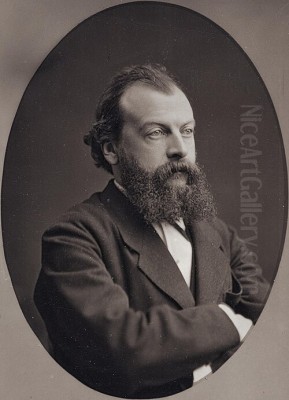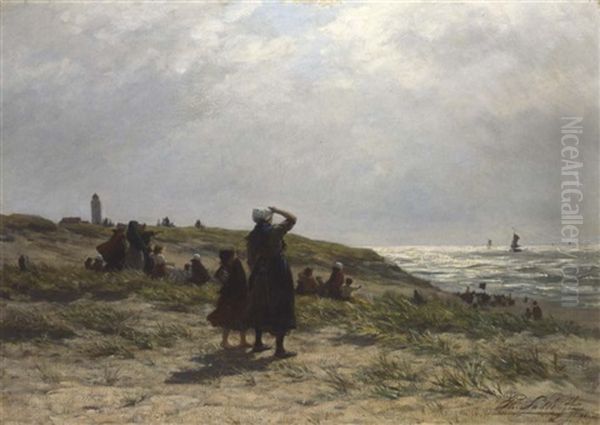
Philip Lodewijk Jacob Frederik Sadée (1837-1904) stands as a significant figure within the rich tapestry of 19th-century Dutch art. As a prominent member of the Hague School, Sadée dedicated his artistic practice to capturing the realities of everyday life, particularly focusing on the coastal communities of the Netherlands. His work offers a poignant and insightful glimpse into the world of fishermen and their families, rendered with a sensitivity and realism that defined his era.
The Context: The Hague School
To fully appreciate Sadée's contribution, it is essential to understand the artistic environment in which he worked. The Hague School (Haagse School) was a movement of artists active roughly between 1860 and 1890, centered around the city of The Hague. These painters turned away from the idealized, romanticized subjects often favored by academic art, choosing instead to depict the landscapes and daily lives of ordinary Dutch people with honesty and atmospheric depth.
The Hague School artists shared an affinity for realism and naturalism. They were inspired by the Dutch landscape, its unique light, and the lives of its inhabitants, particularly peasants and fisherfolk. Their style often featured muted, tonal palettes, emphasizing atmosphere over precise detail, sometimes leading to comparisons with the French Barbizon School painters. Key figures associated with the Hague School include Jozef Israëls, known for his sympathetic portrayals of peasant and fishing life, Anton Mauve, a master of landscape and animal painting (and a cousin-in-law and early influence on Vincent van Gogh), Hendrik Willem Mesdag, famous for his seascapes, the Maris brothers (Jacob, Matthijs, and Willem), and Johannes Bosboom, renowned for his church interiors.
These artists often worked outdoors (en plein air), directly observing nature to capture fleeting effects of light and weather. They sought authenticity, portraying the often harsh realities of rural and coastal life without sentimentality, yet often with profound empathy. Their work represented a significant shift in Dutch art, moving towards a more modern, observational approach.
Sadée's Life and Artistic Journey

Born in The Hague in 1837, Philip Sadée was geographically and artistically situated at the heart of this burgeoning movement. While specific details about his formal training are less documented than some of his contemporaries, his development clearly occurred within the milieu of the Hague School's principles and practices. He became active during the peak years of the movement, absorbing its emphasis on realism and direct observation.
His life spanned a period of significant social and economic change in Europe, including the impacts of the Industrial Revolution, which subtly influenced the backdrop against which artists like Sadée depicted traditional ways of life. He lived and worked primarily in The Hague, drawing particular inspiration from the nearby fishing village of Scheveningen, which became a recurring subject in his work. Sadée passed away in his native city in 1904, leaving behind a body of work that continues to resonate with its honest portrayal of human experience.
Artistic Style and Technique
Sadée's artistic style is firmly rooted in the realism characteristic of the Hague School. He possessed a keen eye for detail, not in a photographic sense, but in capturing the essential elements that conveyed the truth of a scene. His paintings often depict figures within their environment, showing the intimate relationship between the people and the coastal landscape they inhabited.
A notable aspect of Sadée's technique was his practice of making preparatory studies. He often used pencil sketches, created directly from nature, to study the effects of light and shadow. These observations were then carefully integrated into his oil paintings, lending them a convincing sense of atmosphere and place. This method aligns with the Hague School's emphasis on capturing the nuances of natural light and weather.
His color palette often employed the somber, earthy tones favored by many Hague School painters. Browns, grays, and muted blues and greens dominate many of his canvases, effectively conveying the often-overcast skies of the Dutch coast and the humble circumstances of his subjects. However, he was also capable of capturing brighter moments, skillfully rendering sunlight on sand or water when the scene demanded it.
Themes and Subject Matter: The Fisherfolk of Scheveningen
The defining theme of Philip Sadée's oeuvre is the life of the fishing communities along the Dutch coast, particularly in Scheveningen. Unlike artists who might focus solely on the dramatic seascapes or the picturesque aspects of coastal life, Sadée delved into the human element, chronicling the daily routines, labor, and hardships of the fisherfolk.
His paintings often depict scenes on the beach: fishermen returning with their catch, women mending nets or waiting for the boats, families gathered near the shore, and children playing amidst the dunes and fishing gear. These are not romanticized visions but grounded portrayals of a life governed by the rhythms of the sea and the demands of survival. Sadée showed a particular sensitivity towards the women and children of the community, often portraying their resilience and quiet dignity in the face of difficult circumstances.
Through his focused subject matter, Sadée captured a specific way of life that was integral to Dutch identity yet often overlooked by mainstream art. His work serves as a valuable historical document, preserving the visual culture of these coastal communities in the late 19th century. He explored the human condition within this specific context, touching upon universal themes of labor, family, community, and the struggle against the elements.
Representative Works: Fisher Folk
Among Sadée's most characteristic and representative works is Fisher Folk (often titled Vissersvolk in Dutch). This painting exemplifies his thematic concerns and artistic style. It typically depicts a scene involving members of a fishing family, often focusing on the women and children who formed the backbone of the community ashore.
One well-known version of Fisher Folk portrays a poignant domestic scene reflecting the harsh realities of their existence. A mother, clad in simple, worn clothing, is shown perhaps examining or negotiating the price of fish brought ashore, possibly with her child beside her. The figures are rendered with empathy, their expressions and postures conveying a sense of weariness and the constant preoccupation with making ends meet. The setting is usually the beach or dunes, rendered with Sadée's characteristic attention to atmospheric light and muted tones.
The painting powerfully communicates the theme of poverty and daily struggle. The details, such as the rough clothing and the meager catch, speak volumes about the economic hardships faced by these communities. Sadée uses soft browns and grays to create a somber mood, reflecting the often-difficult nature of their lives, yet there is also a sense of quiet endurance in the figures. Works like Fisher Folk showcase Sadée's ability to combine social observation with sensitive artistic portrayal.
While Fisher Folk is perhaps his most frequently cited work, other paintings depicting scenes like waiting for the fishing fleet's return, sorting the catch on the beach, or quiet moments within fishermens' homes further elaborate on these themes, consistently demonstrating his commitment to this subject matter.
Comparisons and Connections within Art History
Philip Sadée's work is best understood in relation to his Hague School contemporaries like Jozef Israëls, who shared a similar focus on the lives of the poor and working class, particularly fisherfolk. While Israëls often imbued his scenes with a deeper pathos, Sadée's work is characterized by a slightly more detached, observational realism, though still deeply sympathetic. He stands alongside figures like Bernardus Johannes Blommers, another Hague School painter known for his depictions of Scheveningen fisherfolk, especially mothers and children.
The Hague School's connection to the French Barbizon School is relevant here. Artists like Jean-François Millet, famous for The Gleaners and The Angelus, shared a similar interest in depicting rural labor with dignity and realism. Sadée's focus on the working poor aligns with Millet's ethos, although translated to a Dutch coastal context. The Barbizon painters' emphasis on landscape and atmosphere, seen in the works of Camille Corot and Théodore Rousseau, also finds parallels in the Hague School's approach, including Sadée's attention to light and environment. Other Barbizon figures like Charles-François Daubigny, known for his river landscapes often painted from his studio boat, also shared this commitment to direct observation of nature.
Sadée's realism can be situated within the broader European Realist movement spearheaded by artists like Gustave Courbet in France, who championed the depiction of ordinary life and rejected academic conventions. While Sadée's style was less overtly political or confrontational than Courbet's, his commitment to portraying the unvarnished reality of his subjects places him within this wider trend.
It is interesting to contrast Sadée's focus with earlier Dutch masters. While he worked within a long tradition of Dutch genre painting, his approach differs significantly from the often more anecdotal or moralizing scenes of 17th-century artists. His work also stands apart from the grand portraiture of someone like Frans Hals (though Hals was much earlier, 17th century) or the detailed topographical prints and drawings associated with artists like Jan van de Velde. Sadée's concern was the contemporary social reality of his time. Even comparing him to his near-contemporary Vincent van Gogh, while Van Gogh shared an intense interest in the lives of peasants and workers (evident in works like The Potato Eaters), his expressive style and psychological depth took a radically different path from the more restrained, atmospheric realism of Sadée and the Hague School.
Legacy and Collections
Philip Sadée's legacy lies in his dedicated and insightful portrayal of Dutch coastal life during a specific period. As a key member of the Hague School, he contributed significantly to the movement's focus on realism and everyday subjects. His paintings offer valuable artistic and social documentation of the fisherfolk communities of Scheveningen, capturing their world with honesty and empathy.
His work was recognized during his lifetime and continues to be appreciated for its artistic merit and historical significance. Paintings by Philip Sadée are held in the collections of several public museums, ensuring their accessibility to future generations. Notable institutions that house his work include the Aberdeen Art Gallery in Scotland, the Whitworth Art Gallery in Manchester, UK, the Brighton Museum & Art Gallery, UK, and Sheffield Museums in the UK. His presence in these British collections speaks to the international interest in the Hague School during the late 19th and early 20th centuries. In the Netherlands, the RKD – Netherlands Institute for Art History holds documentation and information regarding his life and work, serving as a vital resource for researchers.
While the source material reviewed did not confirm his participation in specific, named exhibitions solely dedicated to the Hague School as a group, his clear association with the movement and the presence of his works in significant collections underscore his importance within that context.
Conclusion
Philip Lodewijk Jacob Frederik Sadée remains an important painter within the narrative of Dutch art history. As a dedicated member of the Hague School, he embraced the movement's commitment to realism and the depiction of contemporary life. Through his focused exploration of the fisherfolk of Scheveningen, he created a body of work that is both artistically compelling and socially resonant. His paintings, characterized by their atmospheric sensitivity, observational detail, and empathetic portrayal of human struggle and endurance, offer a timeless window onto the world of the Dutch coast in the late 19th century. Sadée's contribution enriches our understanding of the Hague School and the broader currents of European Realism.